The Thoth Tarot is a living system of symbolism, magic, and psychology. Every layout is a map through the Tree of Life, showing the play of elemental and planetary forces within the querent’s own field of consciousness. Spreads are the framework through which this current reveals itself.
Preparing for a Thoth Reading
Enter the reading as a ritual. The Thoth deck responds best to a state of focused awareness, not analysis. Still the mind, align with your Will, and open to the transmission of image and symbol. Avoid casual or mechanical readings; the Thoth deck was designed to speak through intuition and Qabalistic association rather than surface-level guessing.
Definition
A tarot spread is a structured pattern through which the cards disclose their relationships. In Thoth work, the positional meanings are secondary to the energetic interconnections among the cards. Each card expresses a current, and each position modulates it according to intent and question.
Elemental Dignities in the Thoth Deck
The Thoth deck does not use reversals. Crowley and the Golden Dawn system rely on elemental dignities instead. Each card’s strength or weakness is read through the elements of its neighbours.
- Same element: harmonious, strong influence.
- Opposing element: conflict, tension, or corruption of force.
- Neutral element: no effect or indifference.
- Major Arcana: transcendent; can override elemental interactions.
Opposites: Wands oppose Cups, and Swords oppose Disks.
This system maintains the deck’s occult balance and keeps the reading consistent with its initiatory logic. Reversals are unnecessary; the polarity arises organically through dignities.
Approach
Interpretation in the Thoth system depends on synthesis. The cards are living forces in interplay, not static meanings. Let intuition lead, but anchor it in the structure of the Tree of Life, astrology, and alchemy. Study of The Book of Thoth will refine understanding, but experience is the true initiator.
Simple Thoth Spreads
One-Card Reading
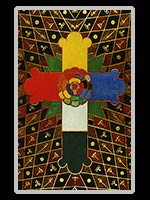
Draw One
A single card reveals the essence of the moment or the dominant force acting within the querent’s sphere. This can serve as a daily meditation or as an invocation of a particular current. Focus on the card’s elemental energy, not its surface meaning.
Three-Card Reading

Draw Three
Traditionally interpreted as Past, Present, Future—or Body, Mind, Spirit—this spread provides a basic triadic rhythm. The Thoth deck’s trumps make this layout especially revealing of evolving cycles of force.
The Blind Spot
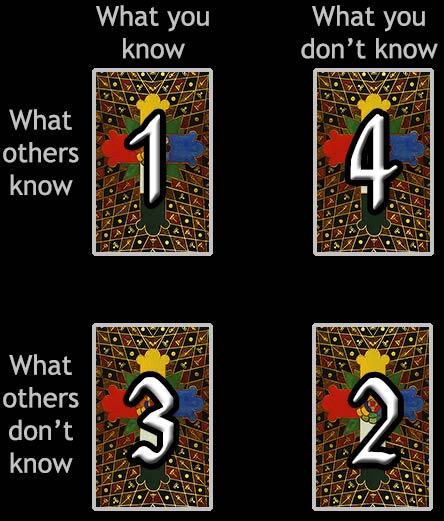
Blind Spot Spread
A four-card layout for self-knowledge.
- The self-image; what is consciously known.
- The hidden drive or shadow aspect.
- The mask; what is deliberately concealed.
- The blind spot itself—what is unseen yet active.
This spread aligns well with the deck’s psychological depth. Cards such as The Moon or The Devil may indicate profound unconscious material.
The Cross Spread

Cross of Four
Ideal for questions seeking clarity.
- The situation.
- The false trail or misinterpretation.
- The true impulse.
- The outcome or synthesis.
When uncertainty surrounds a previous reading, this spread can clarify the original card’s function by showing what it did not mean versus what it truly indicated.
The Horseshoe
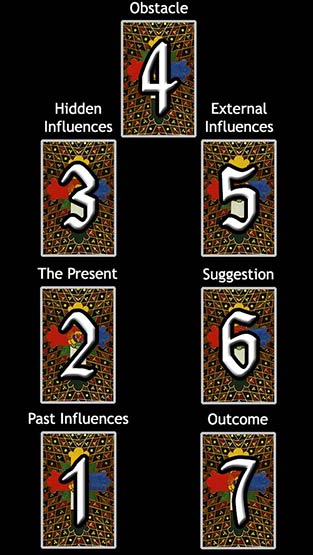
Sevenfold Path
Seven cards arranged in a curve to map time and influence.
- Past cause.
- Present condition.
- Hidden influence.
- Obstacle or trial.
- Environment or others’ influence.
- Guidance or recommended action.
- Result.
This spread demonstrates cause and effect elegantly within the Qabalistic process of manifestation.
Advanced Thoth Spreads
The Ankh
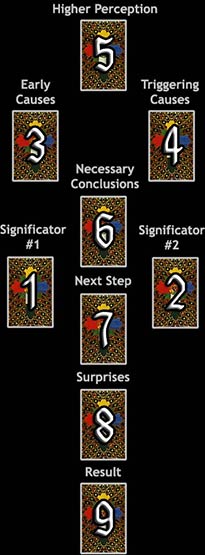
Key of Life
A nine-card spread modeled on the Egyptian cross. The upper loop describes spiritual causation; the stem reveals material unfolding.
1–2. The parent causes (complementary or opposing).
3. Early influences.
4. Triggering event.
5. Spiritual interpretation.
6. Why this path was necessary.
7. The next step.
8. Unexpected developments.
9. Final outcome.
Pause after card six to absorb the causal pattern before proceeding to the outcome triad.
The Celtic Cross
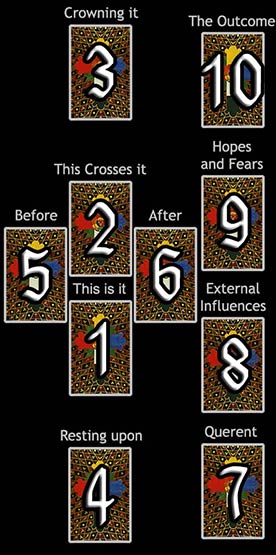
Tenfold Mandala
Still one of the most comprehensive general layouts, though its Thoth reading differs subtly from the Rider-Waite version.
- Significator: the situation or self.
- Crossing force: what challenges or assists.
- Conscious influence.
- Subconscious impulse.
- Past foundation.
- Immediate future.
- The querent’s attitude.
- External influences.
- Hopes and fears.
- Final result.
Study relationships among the pairs: 1–2 (axis), 3–4 (mind vs emotion), 5–9 (past vs expectation), and 6–10 (future development).
The Secret of the High Priestess
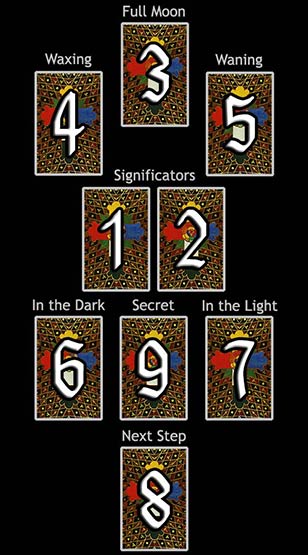
Another Golden Dawn derivative, this spread is ideal for uncovering the inner meaning of events.
1–2. Primary impulses behind the matter.
3. Current influence.
4. Approaching influence (Waxing Moon).
5. Waning influence.
6. Subconscious level (The Dark).
7. Conscious level (The Light).
8. Next step.
9. If Major Arcana—the Secret revealed.
The ninth card acts as the veil of the Priestess, disclosing the hidden synthesis of all forces.
Comic Strip Spread

Ninefold Sequence
A narrative progression for foresight and divination. Lay nine cards in three rows of three. Read left to right as a temporal or causal chain. Observe interactions, directions, and elemental flow between scenes. Particularly effective when working with the vivid imagery of the Thoth deck.
Relationship Spreads
Relationship Layout #1

Nine cards arranged in three rows.
- Center card: the relationship essence.
- Left column: partner one (thoughts, feelings, actions).
- Right column: partner two (thoughts, feelings, actions).
Useful for examining polarity and projection dynamics.
Relationship Layout #2
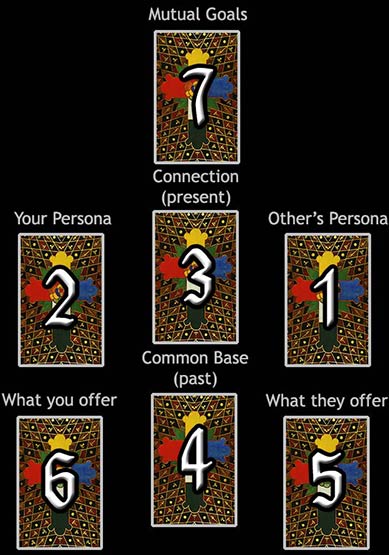
Seven cards focusing on shared evolution.
- Middle column (past, present, future): the shared current.
- Left and right columns: each participant’s individuality and contribution.
Relationships may represent individuals, groups, or conflicting aspects of self.
The Love Triangle

Hexagram Spread
A twelve-card figure composed of interlocking triangles. Used to explore the energetic interplay among three entities—people, forces, or intentions. It reveals alliances, oppositions, and synthesis. Ideal for complex interpersonal or magical dynamics.
The Decision Spread
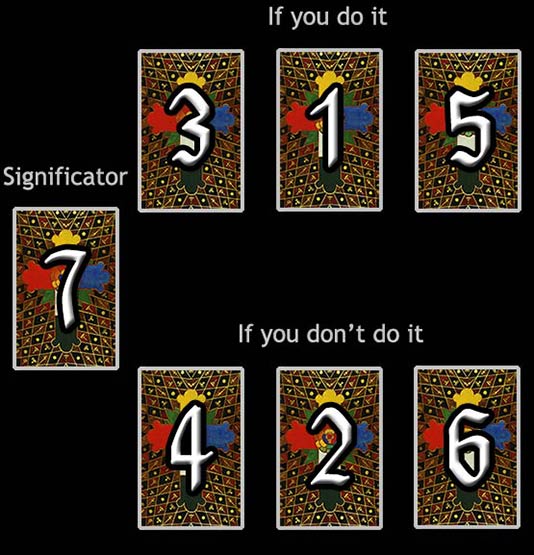
Difficulty: Easy
This layout answers: “What happens if I do X, and what happens if I do not do X?”
It contrasts the outcome of acting versus refraining. It is not a comparison of two separate options—each distinct option would require its own reading.
- Card 7: The significator, the theme of the query.
- Cards 3, 1, 5: The chronological sequence if the reader does X.
- Cards 4, 2, 6: The sequence if the reader does not do X.
Interpretation depends on how the two paths differ. The contrast between left and right columns shows cause and consequence of choice and non-choice.
The Path Spread
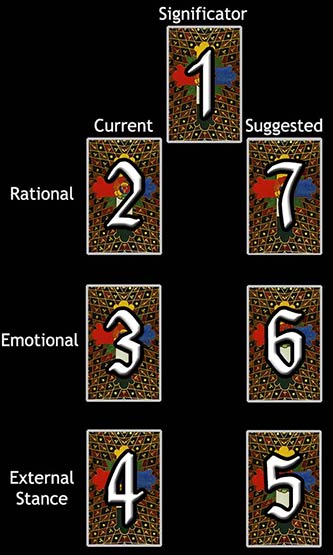
Difficulty: Easy
Purpose: to examine how to behave or adjust one’s attitude to achieve a goal.
The spread is structured in two vertical columns—Current and Suggested—each divided into three levels: Rational, Emotional, and External Stance. The key is to study differences between corresponding cards.
- Card 1: Significator of the question or desired outcome.
- Cards 2–7:
- 2: Current thinking.
- 7: Suggested thinking.
- 3: Current emotions.
- 6: Suggested emotions.
- 4: Current outward stance.
- 5: Suggested outward stance.
Behavioural changes are drawn from contrasts between each pair: 2↔7, 3↔6, 4↔5.
The Game Plan Spread

Difficulty: Easy
For any concrete plan or project. It identifies what motivates it, what to avoid, and what to pursue.
Layout:
- Center—Card 1: The significator.
- Around it clockwise—Cards 2–5.
Interpretation:
- 2: Unconscious motivation or drive.
- 3: How others view the plan or the querent’s ambition.
- 4: What not to do—the collapse path.
- 5: What to do—the success path.
Note contrasts between 4 and 5 for direct behavioural guidance.
The Astrological Spread
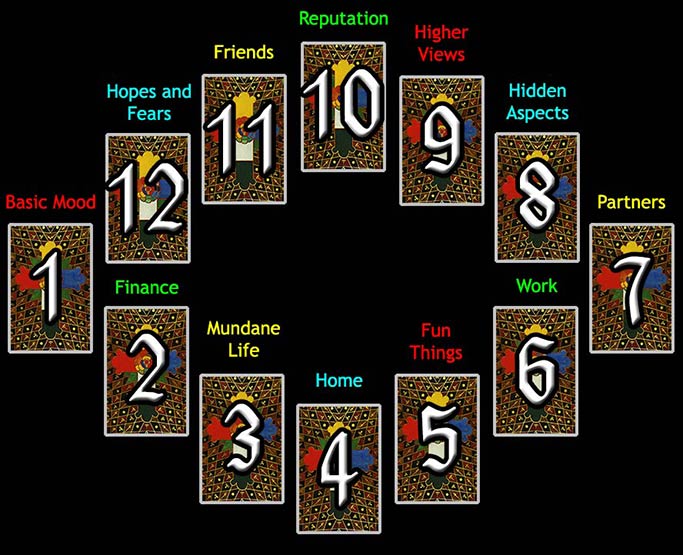
Difficulty: Complicated
A full twelve-card spread modeled on the astrological houses.
Step 1–Interpret each position individually.
Step 2–Examine the main axes:
- 1↔7: Relationship theme (self vs partner).
- 4↔10: Directional axis (present situation vs where one is heading).
Step 3–Read elemental triads:
- Fire: 1, 5, 9—personal drive and development.
- Earth: 2, 6, 10—material affairs, money, work.
- Air: 3, 7, 11—thought, communication, relationships.
- Water: 4, 8, 12—emotion, intuition, desire.
Look also for numerical or thematic sets (e.g., 5-7-8) that repeat motifs within the chart. This spread works well for long-term forecasts or personality mapping.
The Three Pyramids (Self-Actualisation) Spread

Difficulty: Complicated
Composed of a central pyramid flanked by two smaller ones, one inverted. It maps self-knowledge, potential, and integration of shadow and light.
Positions:
1–3: Origins and formative influences.
4–5: The self as it exists now.
6: The potential or higher self.
7–8: Strengths and inner light.
9: What to cultivate within.
10–11: Weaknesses or areas for growth.
12: What to offer outwardly to the world.
Interpret from base to apex as a process of awakening. Strengths (7–8) balance weaknesses (10–11). The spread exposes unconscious architecture behind personality evolution.
The 15-Card Golden Dawn Spread

Difficulty: Complicated
Designed for elemental-dignity reading. Ideal for the Thoth deck. Reversals are excluded. Court cards follow Golden Dawn roles:
- Princes and Queens—real men and women involved.
- Princesses—ideas or messages.
- Knights—arrival or departure depending on direction faced.
Structure:
- Card 1: The querent and central issue.
- Cards 2–3: Elaborate on 1.
Two chronological triplets:
- Current path—4, 8, 12.
- Alternate path—13, 9, 5.
If the two paths feel continuous, read them as one chain: 4→8→12→13→9→5.
Deeper layers:
- 14, 10, 6—psychological undertones.
- 7, 11, 15—karmic or fated influences.
Interpretation depends on elemental relations between neighbours.
- Same suit = reinforcement.
- Opposite suits = conflict.
- Friendly suits = mutual support.
Count elemental prevalence and Major Arcana to identify overarching forces.
The Opening of the Key, First Operation: A Special Thoth Spread
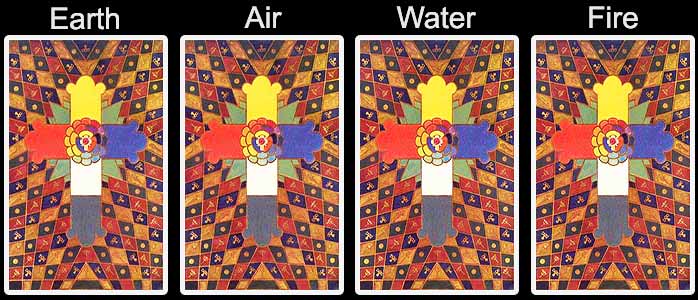
The Opening of the Key is a working in which the Thoth deck is read as an alchemical instrument. It unmasks elemental law within circumstance and discloses the principal current that shapes the querent’s fate. The First Operation confines itself to the four classical elements. Treat it as a laboratory protocol. Proceed with solemn intent and method.
Purpose and Principle
This operation isolates the elemental tonic that governs a situation. The deck is used not as anecdote but as apparatus. The procedure reveals a primary element, then produces a sequence of seven cards that articulate current condition, active influences, and emergent direction. Read it slowly. Let symbolism accumulate into meaning.
Preparation
- Cleanse your space and instruments. Quiet the mind. The operator must be composed and attentive.
- Formulate the question precisely. Avoid equivocation. The operation answers a defined intent.
- Use a Thoth-family deck or any public-domain deck that preserves elemental correspondences. Maintain consistency of deck for comparative work.
The Sequence
I. Shuffle and Divide
Shuffle with focused will upon the question. When the shuffle feels complete, divide the deck into four approximately equal piles. Assign each pile to an element:
- Fire — Wands. Vitality, initiative, transformation.
- Water — Cups. Emotion, instinct, receptivity.
- Air — Swords. Mind, discernment, contention.
- Earth — Disks. Matter, stability, manifestation.
Keep the piles distinct. Allow the cards to rest as four elemental domains.
II. Choose the Significator
Select a card to stand for the querent. Traditionally a Court card tied to the querent’s Sun sign is used. Selection may also be purely intuitive. Place the Significator face down inside the pile you assign it to. Keep that placement secret until the counting reveals it.
III. Identify the Active Pile
Determine which pile contains the Significator either by intuition or a simple cut. Set aside the three inactive piles. The active pile designates the dominant element for this operation. This element frames the reading and registers the principal imminence in the querent’s life.
IV. Counting from the Significator
Locate the Significator within the active pile. Choose the direction of the count. Rightward counts move towards externalisation and outward agency. Leftward counts move towards internalisation and retrospective understanding.
Convert court and special values thus:
- Aces = 11
- 2–10 = face value
- Princess = 7; Prince/Queen/Knight = 4 each
- Trumps = 3 when read elementally, 9 when planetary, 12 when zodiacal
Proceed through the pile by the card’s number. Each card on which your count lands is removed and placed aside. Removed cards are excluded from all further counting and thus function as expended potentials.
V. Reveal the Seven
The Significator with the six cards obtained by counting form the Opening—the seven that compose the Key. Lay them in the order of discovery. Read them as a coherent sequence: condition, active forces, tensions, supports, and trajectory.
Method of Interpretation
Interpret through three interlocking lenses:
- Dignities
- Note elemental affinities. Like elements reinforce. Opposite elements resist. Fire supports Air, opposes Water. Earth stabilises but can bind. Apply Golden Dawn-style dignities where applicable. When reversals are used, treat orientation as modifying dignity rather than substituting for it.
- Relations
- Inspect adjacency and flow. Cards influence neighbours. Seek patterns of amplification or contradiction. A Minor adjacent to a Major will temper archetypal expression. Court cards may represent actual agents or functional energies.
- Astrological Layers
- Attribute planetary, sign, and path correspondences when the card set and deck tradition permit. Read planetary cards as forces, azimuths of movement, or karmic accelerants. Zodiacal counts indicate cyclic themes and timing.
Weigh the active element as tonal centre. The direction of the count modifies emphasis: forward counts favour external outcomes; backward counts emphasise cause and interior revision. The cards removed during counting are not waste; they are echoes and should be read as latent potentials that have been set aside by the operation.
Notes on Practice
- Keep ritual posture. The operation functions better when the operator treats it as a ceremony rather than a parlour trick.
- Record each session verbatim. Logs reveal recurrent patterns and permit later synthesis.
- Vary values only after practice. Do not alter court or trump valuations mid-procedure unless you note the change and test its consequences.
- For decks that do not support reversals, prioritise elemental dignity. For reversal decks, use orientation as a modifier to the elemental reading.
- This is the First Operation. It is foundational. Deeper operations expand the range of correspondences and incorporate additional decks, timing keys, and multi-pile sequences.
Closing
The Opening of the Key is not an endpoint but an aperture. It yields a focused portrait of elemental governance over a question. Contemplate the seven as a unit and as a network. Allow the patterns to instruct further workings. For advanced practice consult the subsequent OOTK operations and the full Thoth sequence.
This site may save a lot of effort, as the push of a couple of buttons works through all these steps. However, this reading should be treated with the same ceremonial focus as any occult ritual, not done in rapid succession flippantly.
May the work be precise. May the correspondences speak plainly.
Closing Notes
The Thoth deck’s architecture reflects the entire Western esoteric tradition—Qabalah, astrology, alchemy, and Thelema. Every spread and reading method becomes a diagram of energy in motion. Use the layouts as initiatory devices rather than fortune-telling schemes. Each card is a mirror of consciousness, and every reading is a ritual of self-realisation.
This page was adapted from the spreads page of tarotsmith.com. To see the original page, go here.